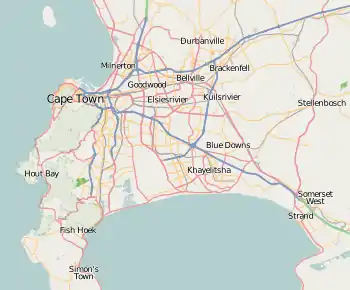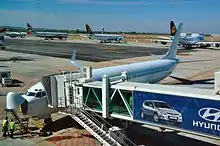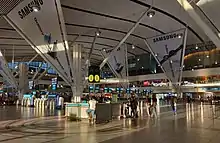Cape Town International Airport
Cape Town International Airport (IATA: CPT, ICAO: FACT) is the primary international airport serving the city of Cape Town, and is the second-busiest airport in South Africa and fourth-busiest in Africa. Located approximately 20 kilometres (12 mi) from the city centre, the airport was opened in 1954 to replace Cape Town's previous airport, Wingfield Aerodrome. Cape Town International Airport is the only airport in the Cape Town metropolitan area that offers scheduled passenger services. The airport has domestic and international terminals, linked by a common central terminal.
Cape Town International Airport | |||||||||||||||
|---|---|---|---|---|---|---|---|---|---|---|---|---|---|---|---|
.JPG.webp) | |||||||||||||||
| Summary | |||||||||||||||
| Airport type | Public | ||||||||||||||
| Operator | Airports Company South Africa | ||||||||||||||
| Serves | Cape Town, South Africa | ||||||||||||||
| Location | Matroosfontein, Western Cape, South Africa | ||||||||||||||
| Opened | 1954 | ||||||||||||||
| Hub for | |||||||||||||||
| Focus city for | South African Airways | ||||||||||||||
| Elevation AMSL | 46 m / 151 ft | ||||||||||||||
| Coordinates | 33°58′10″S 018°35′50″E | ||||||||||||||
| Website | airports.co.za | ||||||||||||||
| Map | |||||||||||||||
 CPT Location within the Cape Town metropolitan area | |||||||||||||||
| Runways | |||||||||||||||
| |||||||||||||||
| Statistics (Jan-Dec 2019) | |||||||||||||||
| |||||||||||||||
The airport has direct flights from South Africa's other two main urban areas, Johannesburg and Durban, as well as flights to smaller centres in South Africa. Internationally, it has direct flights to several destinations in Africa, the Middle East, Asia, Europe and the United States. The air route between Cape Town and Johannesburg was the world's ninth-busiest air route in 2011 with an estimated 4.5 million passengers.[1]
History
D.F. Malan Airport was opened in 1954, a year after Jan Smuts Airport (now OR Tambo International Airport) on the Witwatersrand, near Johannesburg, opened. The airport replaced Cape Town's previous airport, Wingfield Aerodrome. Originally named after the then South African prime minister, it initially offered two international flights: a direct flight to Britain and a second flight to Britain via Johannesburg.[2]
With the fall of apartheid in the early 1990s, ownership of the airport was transferred from the state to the newly formed Airports Company South Africa,[3] and the airport was renamed to the politically neutral Cape Town International Airport.[4] The first years of the twenty-first century saw tremendous growth at the airport; from handling 6.2 million passengers per annum in 2004–05, the airport peaked at 8.4 million passengers per annum in 2007–08 before falling back to 7.8 million in 2008–09. In 2016, the airport saw a 29% increase in international arrivals; 2016 also saw the airport handle 10 million passengers per annum.
Name change
On 16 April 2018, it was reported in the Cape Times that the Minister of Transport, Bonginkosi Nzimande, had directed ACSA on 22 March 2018 to change the name of Cape Town International Airport to Nelson Mandela International Airport.[5] The name change was discussed and as yet no name change had been published in the Government Gazette.[6]
On 5 March 2019, the EFF filed a motion in Parliament calling for the renaming of Cape Town International Airport after anti-apartheid icon Winnie Madikizela-Mandela. One of the arguments of the opposition was that the Parliament is not constitutionally empowered to resolve on any name change and that it was the responsibility of the South African Geographical Names Council (SAGNC) to deal with name changes. The motion was not successful.[7] Until such time as the name change has been published in the Government Gazette, it remains Cape Town International Airport.
Developments
In preparation for the 2010 FIFA World Cup, Cape Town International Airport was extensively expanded and renovated. The main focus was the development of a Central Terminal Building at a cost of R1.6 billion,[8] which linked the formerly separate domestic and international terminals and provided a common check-in area.[9] The departures level of the Central Terminal opened in November 2009, with the entire building opened in April 2010.[8]
Apart from the completion of the 2010 expansion project, it had been proposed that a second runway for large aircraft be constructed at the airport, to be completed by 2015. However, this second runway has not been constructed. In May 2015, Airports Company South Africa announced a R7.7 billion expansion for the airport. The expansion includes the upgrades of the Domestic & International terminals. The expansion project is set to start construction at the end of 2018 and to be completed by mid-2022.
Facilities

.JPG.webp)

.jpg.webp)
Terminal
The airport has two terminals linked by the central terminal.
- Central Terminal
The terminal building has a split-level design, with departures located on the upper floors and arrivals in the lower floors; an elevated roadway system provides vehicular access to both departures and arrivals levels.[9] All check-in takes place within the Central Terminal Building, which contains 120 check-in desks and 20 self-service kiosks.[9] Passengers then pass through a consolidated security screening area before dividing. Passengers flying internationally head to the northern part of the airport which is the international terminal, and passengers flying to other parts of South Africa head to the southern part of the airport to the domestic terminal.
The terminal has 10 air bridges, evenly split between domestic and international usage. Sections of lower levels of the domestic and international terminals are used for transporting passengers via bus to and from remotely parked aircraft.[9]
Arriving passengers collect luggage in the old sections of their respective terminals, before proceeding through new passageways to the new Central Terminal Building.[8] The terminal contains an automated baggage handling system, capable of handling 30,000 bags per hour.[9]
Retail outlets are located on the lower (arrivals) level of the terminal at landside, as well as airside at the departure gates. Retail outlets are diverse, including foreign exchange services, bookstores, clothing retailers, grocery stores, souvenir outlets and duty-free in international departures. Restaurants within the terminal building are located on the upper (3rd) level above the departures level, which includes what is purported to be the largest Spur restaurant on the African continent, at 1,080 m2 (11,600 sq ft).[9] The restaurant level overlooks the airside of the terminal, where a glass curtain wall separates the patrons from the planes 3 storeys below. On the 4th floor is where the airport's lounges are situated. The Bidvest, as well as South African Airways lounges, can be found here.
- International Terminal
The international terminal is located on the northern side of the airport. Customs and Immigration facilities, lounges, duty-free shops, restaurants, prayer rooms, conference rooms, airline offices, and chapels are located in the terminal.
- Domestic Terminal
Located on the southern side of the airport, it has the same facilities as the international terminal with exception of Immigration facilities.
Other facilities
There are two hotels located within the airport precinct, one being Hotel Verde, a four-star hotel owned by Bon Hotels, ranked as "Africa's greenest hotel",[10] and the other being Road Lodge, a budget hotel owned by the City Lodge hotel chain group. An ExecuJet facility is located near the southern end of the main runway and caters for business jets. The airport also has a MyCiti BRT station, which connects across the whole of Cape Town including east of Khayelitsha.
Airlines and destinations
Passenger
- Notes
- ^1 : This flight operates via Victoria Falls/Livingstone.
- ^2 : This flight operates via Harare. Rwandair has full traffic rights to transport passengers between Harare and Cape Town.
- ^3 : This flight operates via Johannesburg. However, this carrier does not have rights to transport passengers solely between Cape Town and Johannesburg.
- ^4 : This flight will operate via Johannesburg in a triangle route. However, this carrier does not have rights to transport passengers solely between Cape Town and Johannesburg.
Cargo
| Airlines | Destinations |
|---|---|
| BidAir Cargo[22] | Johannesburg-Lanseria, Johannesburg-O. R. Tambo |
Statistics
Passenger traffic
| Fiscal year | International | Regional | Domestic | Unscheduled | Total | |||||
|---|---|---|---|---|---|---|---|---|---|---|
| Passenger movements | % Change | Passenger movements | % Change | Passenger movements | % Change | Passenger movements | % Change | Passenger movements | % Change | |
| 2004–05 | 1,176,958 | no data | 126,837 | no data | 4,895,048 | no data | 16,060 | no data | 6,214,903 | no data |
| 2005–06 | 1,167,661 | 149,489 | 5,503,690 | 13,333 | 6,834,173 | |||||
| 2006–07 | 1,246,016 | 147,885 | 6,107,405 | 17,237 | 7,518,543 | |||||
| 2007–08 | 1,309,822 | 145,858 | 6,950,061 | 20,877 | 8,426,618 | |||||
| 2008–09 | 1,378,160 | 138,000 | 6,283,132 | 13,878 | 7,813,170 | |||||
| 2009–10 | 1,284,990 | 122,584 | 6,391,079 | 11,416 | 7,810,069 | |||||
| 2010–11 | 1,261,024 | 122,609 | 6,781,143 | 35,771 | 8,200,547 | |||||
| 2011–12 | 1,400,487 | 133,280 | 7,028,669 | 13,902 | 8,576,338 | |||||
| 2012–13 | 1,325,481 | 144,148 | 6,951,577 | 13,593 | 8,434,799 | |||||
| 2013–14 | 1,355,524 | 143,356 | 6,879,919 | 14,190 | 8,392,989 | |||||
| 2014–15 | 1,452,360 | 150,602 | 7,142,907 | 10,003 | 8,755,872 | |||||
| 2015–16 | 1,564,464 | 179,775 | 7,902,362 | 12,988 | 9,659,589 | |||||
| 2016–17 | 1,934,641 | 197,437 | 8,067,516 | 11,796 | 10,211,390 | |||||
| 2017–18 | 2,243,367 | 208,903 | 8,286,618 | 13,358 | 10,752,246 | |||||
| 2018–19 | 2,406,594 | 195,617 | 8,209,610 | 11,916 | 10,823,737 | |||||
| 2019–20 | 2,356,225 | 183,999 | 8,137,246 | 11,328 | 10,688,798 | |||||
Aircraft movements
| Fiscal year | International | Regional | Domestic | Unscheduled | Total | |||||
|---|---|---|---|---|---|---|---|---|---|---|
| Aircraft movements | % Change | Aircraft movements | % Change | Aircraft movements | % Change | Aircraft movements | % Change | Aircraft movements | % Change | |
| 2004–05 | 4,355 | no data | 4,242 | no data | 56,810 | no data | 27,154 | no data | 92,561 | no data |
| 2005–06 | 4,296 | 4,169 | 58,099 | 22,326 | 88,890 | |||||
| 2006–07 | 4,623 | 3,698 | 60,470 | 22,602 | 91,393 | |||||
| 2007–08 | 5,019 | 3,420 | 69,819 | 24,027 | 102,285 | |||||
| 2008–09 | 5,638 | 3,340 | 65,623 | 21,042 | 95,643 | |||||
| 2009–10 | 4,884 | 3,296 | 65,020 | 19,379 | 92,579 | |||||
| 2010–11 | 4,868 | 3,137 | 66,587 | 19,031 | 93,623 | |||||
| 2012–13 | 4,906 | 3,557 | 62,065 | 18,545 | 89,073 | |||||
| 2013–14 | 4,961 | 2,855 | 60,665 | 20,092 | 88,573 | |||||
| 2014–15 | 5,091 | 3,135 | 64,269 | 18,651 | 91,146 | |||||
| 2015–16 | 5,568 | 4,783 | 70,731 | 19,139 | 100,221 | |||||
| 2016–17 | 7,121 | 5,048 | 71,081 | 16,087 | 99,337 | |||||
| 2017–18 | 9,206 | 5,048 | 72,110 | 16,252 | 103,001 | |||||
| 2018–19 | 10,490 | 4,950 | 67,328 | 15,898 | 98,666 | |||||
Ground transport
Car
Cape Town International Airport is approximately 20 kilometres (12 mi) from the city centre and is accessible from the N2 freeway, with Airport Approach Road providing a direct link between the N2 (at exit 16) and the airport. The airport can also be indirectly accessed from the R300 freeway via the M12, M10 and M22.
The airport provides approximately 1,424 parking bays in the general parking area, and 1,748 parking bays in the multi-storey parkade located near the domestic terminal.[26] A new parkade, which is located near the international terminal and while a provides an additional 4,000 bays, was opened in 2010.[27] The airport also offers a valet parking service.[26]
Public transport
The MyCiTi bus rapid transit system provides a shuttle service connecting the airport with the Civic Centre bus station in the city centre. Buses depart every 20 minutes from 04:20 to 22:00.[28] Transport to and from the airport is also provided by metered taxis and various private shuttle companies.[4]
Rail link
There is no direct rail access to Cape Town International Airport. The Passenger Rail Agency of South Africa has proposed a 4 km (2.5 mi) rail link between the airport and Cape Town's existing suburban rail network.
Accolades
- 2009 – Best Airport in Africa award by Skytrax, ahead of Durban International Airport and OR Tambo International Airport.[29]
- 2011 – Best Airport in Africa of the Airport Service Quality Awards by Airports Council International[30]
- 2012 – Best Airport in Africa award by Skytrax
- 2013 – Best Airport Staff in Africa award by Skytrax[31]
- 2013 – Best Airport in Africa award by Skytrax[31]
- 2018 – Best Airport in Africa award by Skytrax[32]
References
- The Economist, Online (14 May 2012). "Top Flights". The Economist. Archived from the original on 5 June 2012. Retrieved 6 June 2012.
- Bickford-Smith, Vivian; E. Van Heyningen; Nigel Worden (1999). Cape Town in the twentieth century: an illustrated social history. Cape Town: New Africa Books. p. 120. ISBN 978-0-86486-384-3.
- "ACSA – History". Airports Company South Africa. Archived from the original on 20 July 2011. Retrieved 28 December 2009.
- "Cape Town Airport (CPT) Information – Airports Guide to Cape Town". airports-guides.com. Archived from the original on 28 March 2013. Retrieved 28 December 2009.
- Villette, Francesca (16 April 2018). "Cape Town International Airport IS to be renamed". iol.co.za. Cape Times. Archived from the original on 14 February 2019. Retrieved 13 February 2019.
- "Government Gazette online (search)". Green Gazette. 13 February 2019. Archived from the original on 14 February 2019. Retrieved 13 February 2019.
- "ANC shoots down EFF plan to rename Cape Town airport after Mama Winnie". Archived from the original on 6 March 2019. Retrieved 6 March 2019.
- Nicholson, Zara (8 November 2009). "New terminal hailed as a success". Sunday Argus. IOL. Archived from the original on 24 November 2009. Retrieved 28 December 2009.
- "ACSA – New Developments". Airports Company South Africa. Archived from the original on 20 July 2011. Retrieved 28 December 2009.
- "These are the 10 best airport hotels in the world". The Independent. 2 March 2018. Archived from the original on 12 March 2018.
- https://www.logupdateafrica.com/airlink-to-introduce-flights-between-cape-town-and-harare-from-jan-18-aviation
- "AIRLINK FLIGHT SCHEDULE". Archived from the original on 23 March 2019. Retrieved 18 July 2018.
- "New flights open up Napoleon's hidden Atlantic island to international visitors". CNN. 1 November 2019.
- "Cathay Pacific to fly non-stop to Cape Town from November". Archived from the original on 22 February 2018. Retrieved 23 February 2018.
- https://www.travelweekly.com/Travel-News/Airline-News/Delta-returning-to-South-Africa-in-January
- https://www.thenational.ae/lifestyle/travel/emirates-resumes-flights-to-south-africa-mauritius-and-zimbabwe-1.1082847
- "Mango to cancel all Lanseria International Airport flights from April 2020". IOL Travel. 26 February 2020.
- https://www.flytap.com/en-pt/destinations
- "United to start flights to Cape town in December, 2019". PRNewswire. United Airlines. 15 April 2019.
- https://simpleflying.com/klm-virgin-south-africa-flights/
- https://travelweekly.co.uk/articles/386242/virgin-atlantic-outlines-winter-sun-schedule
- bidaircargo.com - Network retrieved 13 January 2021
- "ACSA – Cape Town Passenger Statistics". Airports Company South Africa. Archived from the original on 29 October 2013. Retrieved 23 October 2013.
- "Passenger Statistics, June 2020" (PDF). Airports Company South Africa.
- "ACSA – Cape Town Aircraft Statistics". Airports Company South Africa. Archived from the original on 20 July 2011. Retrieved 28 December 2009.
- "ACSA – Cape Town – Maps and parking". Airports Company South Africa. Archived from the original on 13 November 2008. Retrieved 28 December 2009.
- "More parking comes online at Cape Town International Airport". Airports Company South Africa. 10 December 2009. Archived from the original on 20 July 2011. Retrieved 28 December 2009.
- "Last 'Free Friday' for MyCiti inner city loop…for a while". City of Cape Town. Archived from the original on 21 March 2012. Retrieved 17 July 2010.
- "World Airport Awards 2009 – Regional Results". Skytrax. Archived from the original on 29 May 2010. Retrieved 28 December 2009.
- "ASQ Award for Best Airport in Africa" Archived 11 April 2012 at the Wayback Machine Airports Council International. 14 February 2012. Retrieved 13 April 2012
- "Best Airport Staff in Africa". Archived from the original on 26 April 2015.
- "CT HAS AFRICA'S BEST AIRPORT FOR THIRD STRAIGHT YEAR". Archived from the original on 23 March 2018. Retrieved 23 March 2018.